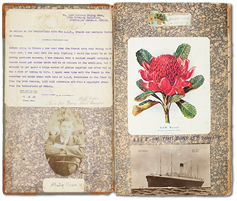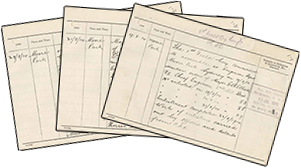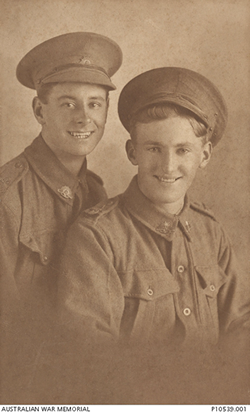
©Mitchell Library, State Library of New South Wales.
Historical research is not always a linear process. As further information is sourced, some questions are answered while further questions are raised. Additional information also helps to make sense of other related material where there was insufficient detail.
Pictured is Philip Ernest Owen’s scrapbook and war diary, 23 November 1916-ca. 1919, an example of a historical narrative. Owen’s service number was 3644 and he served in the 17th Battalion.
Where can I find out more about the veteran’s duties and involvement in the war?
Cover page of AIF 1st Field Company Engineers-Reinforcements Nominal Roll. Australian War Memorial.
Search for a veteran on the People tab at the Australian War Memorial using information from the initial search and details sourced in the service records.
-
Select ‘WWI Embarkation Rolls’ from the left menu
-
Use the name search or preferably ‘browse by unit’
-
Click on the Unit Embarkation nominal rolls
-
Select the specific unit roll of your veteran from the list e.g. 1st Field Company, Australian Engineers.

Find out about Frederick Brightfield’s embarkation.
How do I find out about the what, when and where for events veterans were involved in?

The official unit war diaries provide extensive detail of the work and action of the unit while on active service. Many of these diaries are hand written and use standard abbreviations.
These diaries provide a record of the day to day duties, places, events and actions of the unit. This information supports further research to develop the historical narrative.
With the information sourced from the veterans service records:
-
go to the War History tab at the Australian War Memorial website
-
select ‘Unit and Commander’s war diaries’ > ‘First World War – AWM4’ which lists links to the War Diaries of the Battalions – Australian Imperial Force unit war diaries, 1914 - 1918
-
select the relevant ‘Class’ of diaries from the list
-
search this list to find the subclass record name of the unit of your veteran.

Find additional details on Frederick Brightfield by cross-referencing unit diaries.
Charles Bean writing the 'Official History' at Victoria Barracks. Public domain, Australian War Memorial.
Research the general role and duties of the unit for your veteran. Use a variety of search terms based on information included in the unit war diaries and the veteran’s service records.
Sources include:
Maps, library books and articles are also useful references.
Official History of Australia in the War 1914-1918 edited by official war historian Charles Bean.

Frederick Brightfield’s duties as a sapper personalises his story.
|
First World War diaries and letters provide an individual’s account of the war. A number of these are being progressively digitised and transcribed. Both the Australian War Memorial (Anzac Connections) and the State Library of New South Wales (Our/your war stories) hold a significant collection of personal war diaries. The personal accounts by a veteran’s colleagues can add to the historical narrative. Researching the personal diaries of 1st Field Company Engineers could give details of the conditions and events Frederick Brightfield may have experienced. Vivian Edward Hook (pictured with his cousin), served in the 1st Field Company Engineers, the same unit as Frederick Brightfield. Two of his diaries are held by the Australian War Memorial as a private record. Sapper Leslie Harold Barry from Dubbo, who enlisted 15 September 1915. While serving in the 1st Field Company Engineers in France he was captured by German troops in November 1916. He wrote a memoir based on his experiences. Sergeant Ernest Murray enlisted in August 1914 and served with the 1st Field Company Engineers in Egypt, Gallipoli, France and Belgium. He was awarded the Military Medal twice for acts of gallantry and devotion to duty under fire. After being wounded Sergeant Murray returned to Australia on the Boonah in September 1918. |
 Sapper (Spr) 6293 Vivian Edward Hook and Spr 6273 George William Edward Hook both of the 1st Field Company Engineers. Public domain, Australian War Memorial. |
Unit diaries
Where can I find out more about their war service, the battles and events they were involved in, and a little bit about what the war was like for them?
The Australian Imperial Force Unit War Diaries archives are at the Australian War Memorial.
Unit commanders were required to keep detailed and accurate day to day records on a variety of matters, including details of the campaign along with a variety of strategic information. This information provides a broad picture of events and life in which your veteran would have been directly involved.
Use the brigade, battalion and company details to access the specific unit war diaries, in which your veteran served.
Note that men were often moved into another battalion due to casualties. This information is recorded in the veteran’s service records; along with the dates when changes occurred, which should correlate with information in the unit’s diaries.
War duties
How do I find out more information about the battles, locations and purpose behind the details in the unit diaries?
It is at this point that cross referencing dates in the veteran’s service records with the dates of events in the unit war diaries provides an interesting picture of events and allows a deeper understanding of war experiences. It may also be necessary at this point to access maps of different locations and broader information on specific battles from other sources. The impact of weather conditions in different locations was a significant feature of the First World War, affecting the health, living and fighting conditions of soldiers.
The National Archives of Australia also holds ‘The official History of Australia in the War of 1914 -1918’, a 12-volume series covering Australia’s involvement in the First World War. Six of these volumes were written by Charles Bean, who also edited the rest of the series.
A great deal has been written about the First World War. Search your local library for relevant publications.
What can I do to personalise the story of my veteran?
Including material such as maps and images of different locations, photos of military equipment being referred to, all help to provide a rich context for the veteran’s story. Various collections of photos, items and artefacts can be sourced from a number of locations including the Australian War Memorial, state libraries including the State Library of NSW, the State Library of Victoria and the NSW War Memorial.
If you are researching a family member, additional items such as letters or post cards and oral stories may be accessible through the extended family.
Many soldiers also kept personal war diaries, which are now being digitised and published online. The Australian War Memorial and the State Library of NSW both hold extensive collections of personal diaries. Search the Australian War Memorial People profiles - Biography page and Life Interrupted: Personal Diaries from World War I at the State Library of NSW. Digitisation allows detailed search functions to be applied.
You may be able to find a personal diary written by your selected veteran, but it is more likely that you will be able to find a personal diary written by someone that your veteran knew and served with. These personal diaries provide a very different view to the official war diaries, and add a very personal perspective.
